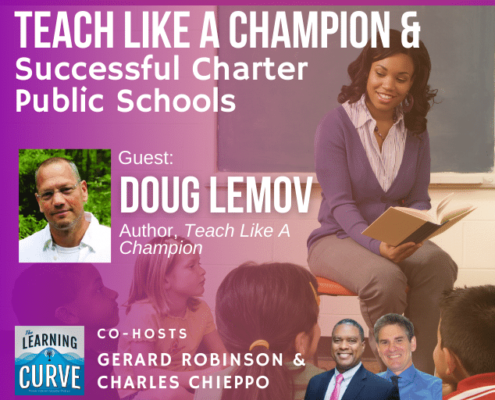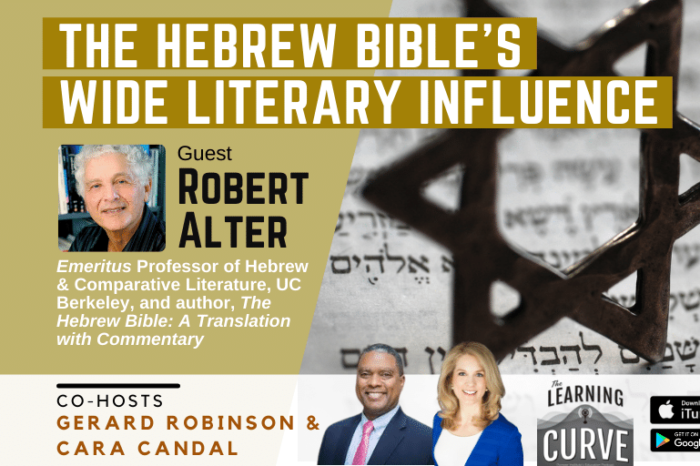UC-Berkeley Prof. Robert Alter on the Hebrew Bible’s Wide Literary Influence
/in Featured, Podcast /by Editorial Staff
This week on “The Learning Curve,” co-hosts Cara Candal and Gerard Robinson talk with Dr. Robert Alter, Emeritus Professor of Hebrew and Comparative Literature at the University of California at Berkeley, and author of the landmark three-volume book, The Hebrew Bible: A Translation with Commentary. As Jews around the world celebrate Passover this week, Dr. Alter shares why the Hebrew Bible is probably the most influential book in human history, and the larger lessons 21st century teachers and students should draw from its timeless wisdom. They also discuss the text as a record of the Jewish people, and vital historical lessons of persecution, resilience, and survival. Professor Alter describes how the Psalms and the Book of Exodus’ stories of liberation and Moses’ leadership inspired several of the major figures of the Civil Rights Movement. The interview concludes with Dr. Alter reading from his trilogy.
Stories of the Week: In California, K-12 public school enrollment has declined below 6 million for the first time in over two decades, with COVID accounting for only some of the loss. New Brookings research explores whether major federal aid packages directed to schools during COVID, and after the 2008 Great Recession, have been used for the intended purpose.
Guest
 Dr. Robert Alter is the Class of 1937 Emeritus Professor of Hebrew and Comparative Literature at the University of California, Berkeley. He started his career as a writer at Commentary Magazine, where he was for many years a contributing editor. Professor Alter has written twenty-eight books, including The Art of Biblical Narrative (1981); The Art of Biblical Poetry (1985); The Five Books of Moses: A Translation with Commentary (2004); The Book of Psalms: A Translation with Commentary (2007); and Ancient Israel: The Former Prophets: Joshua, Judges, Samuel, and Kings: A Translation with Commentary (2013). Most recently, he completed the three-volume book, The Hebrew Bible: A Translation with Commentary (2018), of which The New York Times wrote, “[Alter’s] achievement is monumental, marked by literary grace and intelligent commentary.” In 2009, he received the Robert Kirsch Award from the Los Angeles Times for lifetime contribution to American letters. He earned his bachelor’s degree in English from Columbia University, and his master’s degree and doctorate from Harvard University in comparative literature, as well as being awarded honorary degrees by Yale University and Hebrew University.
Dr. Robert Alter is the Class of 1937 Emeritus Professor of Hebrew and Comparative Literature at the University of California, Berkeley. He started his career as a writer at Commentary Magazine, where he was for many years a contributing editor. Professor Alter has written twenty-eight books, including The Art of Biblical Narrative (1981); The Art of Biblical Poetry (1985); The Five Books of Moses: A Translation with Commentary (2004); The Book of Psalms: A Translation with Commentary (2007); and Ancient Israel: The Former Prophets: Joshua, Judges, Samuel, and Kings: A Translation with Commentary (2013). Most recently, he completed the three-volume book, The Hebrew Bible: A Translation with Commentary (2018), of which The New York Times wrote, “[Alter’s] achievement is monumental, marked by literary grace and intelligent commentary.” In 2009, he received the Robert Kirsch Award from the Los Angeles Times for lifetime contribution to American letters. He earned his bachelor’s degree in English from Columbia University, and his master’s degree and doctorate from Harvard University in comparative literature, as well as being awarded honorary degrees by Yale University and Hebrew University.
The next episode will air on Weds., April 27th, with Dr. Wilfried Schmid, Dwight Parker Robinson Emeritus Professor of Mathematics at Harvard University, who played a major role in the drafting of the 2000 Massachusetts Mathematics Curriculum Framework, and served on the U.S. National Mathematics Advisory Panel in 2008.
Tweet of the Week
What states require in their educational standards has long-lasting effects on individual attitudes and occupational choices. https://t.co/kSPgWw0E4i
— Education Next (@EducationNext) April 6, 2022
News Links
California public school enrollment drops below 6 million mark
https://calmatters.org/education/k-12-education/2022/04/california-public-school-enrollment/
Has federal crisis spending for K-12 schools served its intended objectives?
Get new episodes of The Learning Curve in your inbox!
Read a Transcript of This Episode
Please excuse typos.
[00:00:00] GR: Welcome back to another exciting session with Cara and I on the learning curve. For those of you who celebrated the holiday weekend, hope you’ve had a great time with family, with friends or just yourself. We had a chance to do some great things to family, and it was good to be in a faith setting with people that I haven’t had a chance to be with in over a year and a half.
[00:00:44] So it was good on my end. What about you?
[00:00:47] Cara: we had a very nice Easter. We also celebrate Easter. Thank you for asking. It was, lovely. I ate too much candy, so did the dog, by the way, the dog had gotten into Easter [00:01:00] baskets before the children even found them. So. A little bit of anxiety because you know, dogs are not supposed to eat chocolate.
[00:01:07] she’s fine. So no worries there. But yesterday is we talked a little bit about last week was running of the Boston marathon and I had several friends running at no point in time was I inspired to run because we lived right before what they call. Heartbreak hill, which anybody who has probably ever run any marathon has heard of Boston’s heartbreak hill.
[00:01:28] And so you could just see, this is like the point in the marathon, Gerard worried about mile. I think we’re right after mile 20, where you can see people like making like the calculus going on in their brain. Like, am I just gonna stop now and throw in the towel or am I going to persist? So it was quite a display of.
[00:01:47] think a marathon for me watching I’ve run half marathons in my life, but never marathons watching people persist through that kind of pain is just such a display [00:02:00] of mental toughness. You know, it really shows you the human capacity to overcome pain. When you see people about to ascend heartbreak hill at mile 20 of a marathon.
[00:02:11] So yeah, to me, that’s always just, and thankfully. It was a beautiful day for it. Probably a little too hot actually for the runners. It was in the mid fifties. I think for me, that’s too hot.
[00:02:23] GR: Just brutal. Yeah.
[00:02:25] Cara: Well, I like to run in the thirties, but you know, yeah, of
[00:02:28] GR: course, of
[00:02:29] Cara: course , it’s the best kind of running and I bet you people will, will agree with me, listeners, send us an email for your career or get us on Twitter, but anyway, beautiful day.
[00:02:37] and really. Such a wonderful event for not just the city of Boston, but the Commonwealth of Massachusetts, especially those communities that are along the route. it’s a feeling unlike any other.
[00:02:48] GR: And let me give a shout out to UVA. President Jim Ryan who ran his 11th straight Boston marathon.
[00:02:55] And this time he’s doing it for veterans as many of our listeners know he’s the former. Dean of the [00:03:00] Harvard graduate school of education, but he is an avid runner and he is doing it for a good call. So I want to make sure as someone who works UVA, wanna give him a president of the shout-out impressive.
[00:03:10] Cara: Jared, have you ever thought about, have you ever run a marathon or thought about running.
[00:03:14] GR: No. What I do is watch it on TV or when friends of mine decided to do so, I’m like I cheer on I’ll donate money to their calls, but I am not a runner unless chased or chasing someone. Cause I need something. But other than that, no running legs here.
[00:03:31] Cara: Yeah. Yeah, no, it’s something I’ve thought about it. I think I might’ve mentioned last time I ran a half marathon, seven months pregnant. Yeah. Cause that’s a good idea. Especially when, especially, you know what it was, it’s my competitive spirit. My husband was going to do it. And of course at the time when we signed up for the marathon, I don’t even know if I knew I was pregnant yet.
[00:03:52] but once, I discovered that he was going to do it, I was like, yeah, yeah, no, no, no, no, no. I’m going to do this and I’m going to beat you,[00:04:00]
[00:04:01] but I would never do it again. I finished that half marathon and I thought to myself that is an activity I will never engage in again, as long as I live. So. It’s stupid because I hadn’t trained. Anyhow. We’ve got quite a show ahead of us as always. I’m just curious to know what you’re going to be ranting about this.
[00:04:21] GR: So my rant is about my home state, where I grew up California. And this is from Cal matters. Joe Hong is the author and it says California public school enrollment drops below 6 million mark. So for the first time, since the start of this century, California has fewer than 6 million students attending public schools.
[00:04:44] And this isn’t only a drop in public schools, writ large. Charter schools also saw a decline for the first time since 2014. Now when the department of education began to desegregate data, they identify a few points. So for [00:05:00] example, kindergarten enrollment is up, but nowhere near the pre pandemic level this year, now the schools are open kindergarten enrollment was up by more than 7,000 students recovering slightly from the loss last year.
[00:05:14] 60,000 students. Now on the private school side, there are more than 9,000 students. Who’ve enrolled in private school, roughly a 1.7% increase, but that doesn’t explain the major exit is from public schools. So the author makes a couple of good points. We said these, hold on to number one. He reminds us that enrollment in California was on a steady decline for more than a decade, even before the pandemic.
[00:05:42] And what reason did he name? He said mostly due to the lack of affordable housing. And so. People began to move and change. Well, this brings me to the point to the president of the California charter schools association, Myrna casserole. She said [00:06:00] this to the client also illustrates how charter schools are facing the same statewide challenges as our non-public charter school or non-charter friends.
[00:06:09] And she’s called for equitable funding. And so through the article goes down for how many first graders were here. But here’s one thing, even though the numbers for kindergarten went up enrollment numbers for first graders drop 18,000 students this year. And it raises questions because they said, wait a minute, we had a nice enrollment last year.
[00:06:33] So students who qualify for kindergarten, who now qualify for first grade. Thousands of them are not coming back. And when the California department of education was asked for a comment it said it wouldn’t comment on where those students went and some school districts are trying to find an answer.
[00:06:49] So at the state level, the governor said, well, I tell you what in California funding is driven in part by enrollment and attendance. So governor Newsome said, [00:07:00] what he wants to do is to allow districts to use a three year average attendance rate to calculate next year’s funding. The reason for looking at three years, it would bring you pre pandemic pre dropping numbers.
[00:07:13] And it will look at attendance versus enrollment because for holster reasons, as the authors identify, we’ve lost a lot of students and department of ed. Cannot necessarily identify who, what, where, when or why. There are also some privacy reasons to consider. There’s also a state Senator who introduced him to bill eight 30 to help with funding.
[00:07:35] So I will buy that affordable housing is one factor. do I, there is a drop in the number of students in California, but I decided to even do a deeper dive. And so it took a little. Article in the Los Angeles times from December 18th, 2021. And in that article, the author says the California population.
[00:07:57] Yes. Continues the client and [00:08:00] is putting in perspective. well, the drop below 6 million, isn’t just a drop for students. Many of those students are in homes or communities where there’s also a drop. So California itself has a decline. Why? Well, one driven by lower immigration to fewer deaths, well, fewer births and some pandemic deaths.
[00:08:21] And so I said, wow. So yeah, decline in students. Affordable housing. Got it. There’s also a drop in the population, at least according to one author, Lord immigration got, if you were birthed comma, pandemic deaths. And I said, well, that’s going to have an impact on the state as well. Well, what people may not know is that for the first time, in the 171 year history of California, since this data has come out and identify that not only the California.
[00:08:49] Have a drop in population as a result, it actually lost a congressional seat moving from 53 house districts to 52. Now that may not mean much to people outside of [00:09:00] California, but it matters a lot to people in California. Why? Well, one fewer state Merck in the house means one fewer vote in the electoral college, which helps decide who’s going to be president.
[00:09:12] There’s going to be less than 1.5 trillion in federal money distributed to the state each year. So I said, but there’s gotta be something other than that, or in addition to, but most of the answers that I’ve read so far have a lot to do with what’s taking place in. And then I’m sad to read an article by one of my colleagues at the American enterprise Institute Mark Perry, and he’s written for years about why people decide to leave states.
[00:09:42] And what he decided to do is to look at the number of view halls that leave one state and go to another. And so what he’s identified is that between 2010 and 2019, that The top 10, mostly blue states lost 845,000 [00:10:00] citizens. While the top 10, most red states actually gained a million. And so I did a deeper dive.
[00:10:06] I said, well, where are the states? So in 2021, the top 10 inbound states are Florida followed by Texas, Arizona, North Carolina, South Carolina, Tennessee, Georgia, Idaho, Utah, Nevada. And. Some of our listeners, won’t like this California, a, the number one outbound state followed by New York, Illinois, Massachusetts, New Jersey, Louisiana, Maryland uh, Y and Minnesota, as well as Michigan, your former home state.
[00:10:36] So I put into perspective, California, student enrollment. By 6% is influenced by a lot of factors. Affordable housing is one, immigration is another, so our pandemic deaths as well as birth rates, but let’s also put in mind that people are leaving the state and going to states that have lower taxes and have had a [00:11:00] higher, in fact, a lore, unemployment rate.
[00:11:02] States that are providing tax breaks for businesses. So when I look at the numbers, it’s an education discussion, but it’s a broader discussion about demographics taxes and public policy. I’m
[00:11:16] Cara: very good. Blue states are getting nervous when they hear you say that, especially talking about declining census data and losing representatives.
[00:11:25] And but I think we know it’s true. And we know that a lot of these states where you’ve named where folks are going have been working hard to get folks to there. And we can talk about, I think you’re right. It starts with an education conversation, but it’s different than that because some of those states.
[00:11:38] I also have a lot of work to do on their education systems. But I want to go back Gerard and ask you a question about governor Newsome’s fix here because now granted, we are coming out of a pandemic enrollment seems unstable bloody bloody blah, but sounds like you’ve got some pretty good numbers that this is a pre pandemic problem, right?
[00:11:57] Enrollment’s been going down for a long time for many of the [00:12:00] reasons that you named. So. In your mind is the right answer to say, well, let’s just pack things for awhile and make this. I mean, I, do listen. I do, to some extent, get the argument. wish that we didn’t have to make it because I wish our school districts were more efficient and less lumbering than they are because they are these lumbering bureaucracies that don’t seem to be able to adjust really well when suddenly they don’t have as many kids in the schools they thought they did, but to take an approach that sort of past.
[00:12:28] Funding for kids who weren’t there over a longer period of time. I wonder about the extent to which that really solves the problem, which is school districts need to adjust. They need to be nimble California, unless it’s suddenly housing stock, becomes much more affordable unless a range of other things happen.
[00:12:46] He’s probably not going to recover its population in the near term. And so what does that mean for. Spending money on things like propping up empty facilities. We have this problem here in Boston that money is not necessarily going to kids and going [00:13:00] to their education. So I’m curious as to what you think of that.
[00:13:04] GR: I accept his proposal as a stop gap measure to try to hold harmless schools for one to two years. So for that, I’m fine with the green length. I also know that California’s got billions of dollars and cares money that’s going to the state for some students, in fact who may not be there now. And so I don’t want money to be a reason why the state can’t move forward to try to fix this.
[00:13:30] So in this. Um, A green light on it. You’re a
[00:13:33] Cara: green light on it. Okay. Yeah. think that it’s hard not to be in the short term. My question is, will they change things in the term? You know, we know that yeah. Now these states could be using this opportunity to say, Hey, here’s an idea. Let’s turn towards a model of student centered funding.
[00:13:52] It doesn’t seem to be. The table.
[00:13:56] GR: Yeah, no, that’s actually a good point. No, they, won’t change because [00:14:00] there are no legislative incentives to do so, uh, California funding model is really different than most states because there’s also a community college dynamic as well. So no, they won’t go to a we call it backpack model of the money following the stigma.
[00:14:14] They won’t do that. The question will be two years from now. Are you going to continue to keep attendance and enrollment when you get to year three? And you’re saying attendance and not enrollment are now we have a problem because you have go students and that students were actually there. So I’m going to give them the benefit of the doubt for two years, but I don’t expect a major push, but in the article, superintendents were saying we’re having to compete with each other for students and you’re competing.
[00:14:44] Like private schools and like charter schools and like cities you’re competing for talent. So it is a interesting story. But this is a story about California dreaming in reverse,
[00:14:57] Cara: and dear they insert [00:15:00] competition into education. It’s not bad. Well, you know, you mentioned this also, I mean, my ears perk up , like you said, California’s got a bunch of money and a bunch of cares funding.
[00:15:12] And with kids leaving, they should have extra to spend on the kids. Yes. Maybe, I don’t know, my, article, it’s a question is will they spend it on things that will ultimately benefit kids? I’ve got this really interesting piece. It’s from the Brookings Institute blog, the brown center chalkboard by Kenneth shores and Matthew Steinberg.
[00:15:30] And they’re blogging about a research paper they just did. And I just it’s really cool. I mean, I think that, you know, Three really broad questions, which I sort of love. And they’re looking at main question they asked is, has federal crisis spending served its intended objectives. That’s the title of the blog.
[00:15:51] And the big question they’re trying to ask, and then they’ve got three sub-questions here. So they’re looking at American recovery and reinvestment funds. Remember. [00:16:00] Remember that. Yeah, the American recovery and reinvestment act after the great recession. And they’re also looking of course at Esser funds.
[00:16:08] So as a reminder, a R R a funds were about 50 billion and the whole purpose was to give money to the state. So they could simply like get school budgets up to pre-recession levels. And then of course, as our funds, we’re talking $190 billion Gerard. And so they wanted to look. Three things specifically, the first was where the funds allotted sufficient to basically meet the policy goal, which in this case is to offset learning loss where the funds allocated to the districts with most need.
[00:16:40] And were they used in a way that would help districts meet the purported policy goals. So again, to recover learning loss, so on all counts. And this is a really interesting example of us. I mean, why are we were asking this question about a R a now and there were very few studies, there were couple done at the time to see like, [00:17:00] okay, so what difference did it make, if any, and it’s not to say that it didn’t make some difference.
[00:17:04] It did. I certainly have memories of entering schools to do research studies after they had received ARR funds and Nam. There were a lot of nice looking Smartboards hanging in those schools that nobody knew. But, there were some definite good infrastructure changes that happened. And I think, but these authors conclude that if you really look at.
[00:17:23] these questions, were the funds sufficient to offset learning loss where they allocated to districts most in me, by and large, the answer is no. So surprise, surprise, right? Under a R a, it seemed to work a bit in the beginning, but really at the end of the day, they said the funds weren’t enough to get the districts that needed it most back up to pre-recession spending levels.
[00:17:44] Now we know we’ve had lots of people on the show that does tell you spending isn’t everything, budgets, aren’t everything, but. In the context of a budget, taking a sudden and big hit. I remember being on the board of a charter school at this time and us realizing like, wow, halfway through the year, luckily this all states, [00:18:00] all schools were experiencing this and, and state had to help make up for it, but we really taking it.
[00:18:04] It was a big budget impact and he had tough decisions to make them very short notice. And so there really weren’t enough funds under a R a this is fascinating to me under. What the authors conclude is that actually well, first of all, if the policy goal is to offset learning loss, we don’t know the extent of learning loss still.
[00:18:26] We’re still trying to figure it out. And we don’t know the extent of learning loss, where one thing that we do know is that as extra funds were being allocated states, actually weren’t taking as big of a budgetary hit. As we’d predicted they would in the beginning from COVID right. Budgets actually turned out to be pretty.
[00:18:47] Okay. But under if you look at the most dramatic predictions, , around learning loss, you would still come up a little bit short in terms of are the funds allocated enough to actually address learning loss. So let’s [00:19:00] put that in the bucket of, we will see the other really interesting question around.
[00:19:05] We’re the funds getting to where they needed to be. That is the districts that were hurt as tit the districts with the students that were already suffering the greatest, gaps in learning. And in there, the story again is very interesting because under a R R a it wasn’t so much targeted.
[00:19:21] At we’re going to target low income districts because states were already doing that. They sort of handed the money over to states and then states follow their own formulas. And a lot of states were already giving more funding to lower income districts, but under Sr, remember, we distributed those funds using title one model.
[00:19:38] So theoretically the districts who needed the most should have gotten the most and by and large, that did happen. But here’s the thing. Learning loss. We were in this unprecedented. Everybody stays at home and learns online and loses learning pandemic. So what it turns out to be is that if you run the models, it’s the district.
[00:19:55] That receives the least amount of money. Those that were more well lost, they arguably still [00:20:00] suffered the same, for example, like years of learning loss as other kids. So it’s a real question as to whether these funds realized their stated goal, right. Or the government’s stated goal, but here’s the final one.
[00:20:13] And this is. The kicker, the final question was, were the funds actually, were they working to meet their purported goal? And here’s a little quote from the article around what we learned about a R a from several studies at the time. And that was at the end of the day, to understand whether or not these funds were actually impacting learning loss that we needed greater transparency, greater accountability.
[00:20:41] And more data. Now, if you look at what we’re struggling with now, I don’t know if you’ve read some of these district plans on how escrow funds are being sent Gerard, but I have, and nine times out of 10, they tell you absolutely nothing. This is I’m reading this article also on the same day. Us ed has announced that they’re going to be having a [00:21:00] summit profiling, how districts are spending their funds.
[00:21:02] I’m sure some of them are spending them well, but at the end of the day, we really don’t know how those funds are being spent. They had certain parameters, but you could probably drive a truck through most of those parameters. So I think that my prediction Gerard is going to be that 10 years from now. If you and I are still talking about this.
[00:21:21] We are going to find out that the studies conclude we need greater transparency, greater accountability, and better quality data to figure out whether or not this, how much did I say at the beginning? Oh, I’m sorry. $190 billion in SRP. Actually did anything just I’m learning loss. So that’s my story. I highly recommend this study and this blog to our listeners, because it’s an interesting one.
[00:21:49] And I don’t think we should forget that these districts are going to be spending extra funds for at least the next few years, Gerard. And they’ve got a long way to go and doing it the right way.
[00:21:58] GR: So much of what you [00:22:00] said. I’m going to say ditto, ditto, ditto. It’s a shame. And they actually look 10 years in the future and have a conclusion that’s going to be 80% in the ballpark.
[00:22:09] 10% of be totally off or the additional 10% of the worse in terms of the prediction. But you know what, when we look back through different presidents administration is, and we see the different theme-based investment to make work. You’re going to come back to. Yep. He didn’t work well, it didn’t do this, Yeah. I just leave it at that because it’s just, this is not a hard thing to do. You can actually follow the money. When we look at charter school malfeasance, we know every dime. We know every corner that was cut when a school that has a voucher school or a school receiving private school funds. When it’s time to close the newspaper, we’ll run an export.
[00:22:52] Telling you, how much the principal made the car? He or she drove using public funds. The amount of money that was used as kickbacks to vendors. , they’ll [00:23:00] lock the length. And when we come to traditional public schools, where’s the money going? We’re not always sure, but we as taxpayers, let this.
[00:23:09] Cara: We do, we absolutely do.
[00:23:11] And let our districts off the hooks and they educate the majority of our kids. So we should not be doing that Gerard. And also like, can we maybe just start talking about accountability on the front end? I don’t know. That’s what we do when we design policy for the most part at the state level.
[00:23:25] Let’s maybe ask ourselves that question. Hopefully we don’t find ourselves in another pandemic right away. The next time we need to make a huge investment. If there’s another coming recession, let’s remember that 190 billion. And not create regulations that you could drive a truck through.
[00:23:39] GR: So, Ooh, it just reminded me.
[00:23:42] And in terms of accountability, we know that we have a school to prison pipeline. It seems that we’re more interested in holding students accountable while they’re incarcerated and making sure the institution, the department of correction, or the department of juvenile justice to make sure they do all the things right accountable to keep the public’s money.
[00:23:59] [00:24:00] Great. At where, when they’re in the free world, you don’t seem to have that same level of transparency and oversight. Just my thoughts.
[00:24:06] Cara: It’s a fascinating observation. I think we need to do a whole show about that at some point. All right. But you’re right. We’ve got to bring in our fabulous guests because in just a moment, listeners, we are going to be speaking with Dr.
[00:24:16] Robert Alter and he is the Ameritas professor of Hebrew and comparative literature at the university of California, Berkeley. So we’ll be back in just a minute.[00:25:00]
[00:25:29] Welcome back learning curve listeners. We are here with Dr. Robert Alter. He is the class of 1937 emeritus professor of Hebrew and comparative literature. So university of California, Berkeley, he started his career as a writer at commentary magazine, where he was for many years, a contributing editor.
[00:25:47] Professor Alter has written 28 books, including the art of biblical narrative, the art of biblical poetry, the five books of Moses, a translation with commentary, the book of Psalms, a translation with commentary [00:26:00] ancient Israel, the former. Joshua judges, Samuel and Kings a translation with commentary. And most recently he completed the three volume book, the Hebrew Bible, a translation with commentary of which the New York times wrote alters achievement is monumental marked by literary grace and intelligent commentary.
[00:26:20] In 2009, he received the Robert Kirsch award from the Los Angeles times for lifetime contribution to American. Here in his bachelor’s degree in English, from Columbia university and his master’s degree and doctorate from Harvard university and comparative literature, as well as being awarded honorary degrees by Yale university and Hebrew university, professor Robert alter.
[00:26:41] Welcome to the learning curve.
[00:26:43] Robert Alter: I’m glad to be here.
[00:26:45] Cara: Well, we’re glad to have you. And I’d like to start by asking you about your landmark book that I just mentioned the Hebrew Bible, a translation with commentary. It turns wise praised and it’s perhaps someone say the best translation now available in print.
[00:26:59] Could you [00:27:00] share with our listeners why the Hebrew Bible is probably. Influential book. Some would say that humans have ever produced and talk about, especially for teachers and students in the 21st century. I know it’s probably hard to wrap that into one little nugget, but what would you think they should draw from its knowledge and.
[00:27:18] GR: Well,
[00:27:19] Robert Alter: the obvious explanation, why the Bible has been that influential is that both Tues and Christians conceived it over the ages to be. Divinely inspired. So it was the guidebook to living the good life and blueprint for theology or generated many different theologies on the part of different things.
[00:27:46] But to me, what is interesting is that the Bible, especially I’ll focus on the Hebrew Bible which I think is different in kind in many respects for the new Testament. It [00:28:00] seems to me that the Bible transcends it’s strictly religious theological or doctrinal function. Because it is a very rich, it is in some ways, interestingly, contradictory representation of the.
[00:28:21] People struggling with their deaths in these, with the tangle of family relationships, with politics and what that does to a human being and so on and so forth. So that that’s one reason why not the only reason. So many readers who are not believers have felt that these books speak to them that they tell them something about the human condition that they provide a certain illuminating perspective on their own [00:29:00] lives.
[00:29:00] Cara: I want to pick up on that because You said that even for non-believers, it can provide an illuminating perspective on one’s own life. I mean, especially today, even, I don’t know if this is a product of me getting older, or if it’s quite real, you know, children, my own children, I look at them and I think, wow, they’re living in a time of, feels like heightened conflict.
[00:29:21] Heightened because they’re so close. Yeah. Having this understanding of it because they have such at their fingertips, the ability to, they don’t have to go far to get a Facebook feed or an Instagram notice or whatever it is that how kids get their news today. And so there’s a real need to understand how to resolve conflict, how to be a resilient, human being and survive in the face of these great challenges.
[00:29:47] Can you maybe point to. A specific story or a specific way in which an understanding of the Bible as a record of these things can help anyone confront [00:30:00] conflict or become more resilient in life.
[00:30:02] Robert Alter: Okay. First, all as your question implies, conflict is all over the place. And the Hebrew Bible because last conflict is all over the place in our history in general and all the more so at this particular moment in time.
[00:30:22] So I would Particularly focus on what seems to me, one of the greatest narratives to be produced anywhere in the ancient world. And that’s the story of David now? Okay. You think of the medieval representations of David and Christian iconography. He has a halo around his head and he’s playing a harp.
[00:30:49] And in Jewish tradition, he’s studying the Tom motor, which of course has not been composed when he was alive. But in fact, he’s much [00:31:00] more complicated and interesting and Merck. Then all those pies representation David starts off as a charismatic young man. He’s beautiful. Everybody falls in love with them.
[00:31:16] He gets into the court, but he’s been clandestinely anointed. To become the king after Saul. And that gets into the story in a whole complicated network of political machinations. Seoul eventually becomes fixated on David and a. Paranoid way, dividends, plea, and on and off. And then once David does become.
[00:31:47] King the story of conflict is not over. his forces and up in a civil war with the 10 Northern tribes [00:32:00] and once that’s resolved he has plenty of problems with his. military commander Joe out who seems to be the power behind the throne and in many ways, manipulate David And then his own son, Absalom, rebels against them. And you serve the throne. have a figure in some ways to kind of tragic figure, because the conflict between his screen, your private person, a man who loves his father the king are irreconcilable. And yet there is the kind of. Persistence in greatness and David for all his flaws.
[00:32:43] The worst of which is murdering Uriah after David has had an adulterous relationship with you, arise life, despite all that, there is something. And [00:33:00] during and noble and heartening about him. So although I hesitate to call anything, a lesson from the Bible, you can see how reading that story.
[00:33:13] you get a sense of how are you in. with all his mistakes and all his terrible conflict can persist in history and do something with his life.
[00:33:26] GR: You spent a great deal of time talking about human conflict and that’s definitely something that’s a part of what we read. I want to talk with you about the book of Exodus.
[00:33:36] Now there’s several major leaders of the American civil rights movement. Most notably Dr. King who’s heavily influenced by and drew inspiration from the book of Exodus. Be it as themes deliberation or Moses’s leadership. What did you say to our teachers and students? Really of all faiths and political viewpoints, what can they learn from the Exodus story to better understand human cohesive?
[00:33:59] Robert Alter: [00:34:00] To begin with, there has been your listeners should be aware of a whole movement in Latin America called liberation theology, which is largely based, or at least takes this point of departure from the. Michael, what the intellectual history in
[00:34:24] advanced studies years ago wrote a book called exit this and liberation, which follows this trajectory. So I would say Peculiar about the exit, his story that is this a story of national origin, but most people’s trace their origins to some glorious triumph in the past, like think of a virtual India and the, way the founding of the Roman people.
[00:34:56] Based on or can be traced [00:35:00] back to a knee is fleeing from conquered Troy, but, in acting a grand military triumph in the Italian peninsula, by contrast the Exodus story low, it’s the origins of the people in slavery. Which is almost a shocking idea. but it’s also parroting idea that is a people who has been added to.
[00:35:29] No freedom who is been worked like dogs. And in fact is then doom by a genocidal to create affecting all the Hebrew males coming from the Pharaoh. This people. Manages with the leadership of Moses recourse to extricate itself from the house of bondage and to become a great people. So it’s moving story.
[00:35:59] [00:36:00] And as I said, different from most stories of national.
[00:36:04] GR: Well to take that a story, just another step right now, Jews all over the world is celebrating Passover, which marks the Exodus of the Israelites from slavery to Egypt. Your translation of the Hebrew Bible, as we’ve said earlier, is considered a definitive.
[00:36:20] Could you talk about what educators and young people should know about the biblical narrative around this holiday?
[00:36:27] Robert Alter: I think what they should know is pretty much what I’ve just said, look, the history of the Jews after the Bible is, well, first of all, the history of the Israelites in the Bible A series of defeats.
[00:36:44] It’s little sliver, a country sandwiched in between great empires to the east and the south that the Assyrians conquer the Northern Israelite kingdom and obliterate. [00:37:00] Eventually the Babylonians conquered that Southern kingdom, then it becomes a kind of province of the person empire. So there is defeat after defeat.
[00:37:11] And then in the post-surgical period, of course, as a diaspora people, Jews were repeatedly subject to Persecution for grumpy wide-scale massacres that wasn’t all the two shifts. It was certainly an important part. And yet every year, To sit around table and they celebrate freedom. They celebrate the fact that we have come out of the house of bondage and now we are free people.
[00:37:46] So is kind of inspiring story. And certainly that’s one of the reasons why it has grabbed all kinds of Jews year after year, every April, when Passover comes here.[00:38:00]
[00:38:00] GR: Absolutely. part of any celebration is often sacred songs are sacred poems and your book, the art of biblical poetry, you’ve written about the power of poetry.
[00:38:12] Could you talk about the influence of songs and what we can learn from it regarding the ability of words and language to inspire?
[00:38:20] Robert Alter: Okay. Now it is sometimes said, but I think it’s not persuasive that the Psalms or the origin of lyric poetry the west, but what they are and the way that I think they have spoken to readers, both pious and secular is.
[00:38:43] There is a powerful, poetic expression of anguish and desperation. There are many of the Psalms where speaker in the poem seems on the point of death. And yet at the end is [00:39:00] rescued by. which is again, the agreement’s story with a happy ending. then there are a great variety in the book of Shawn.
[00:39:10] There are exuberant celebrations of the glories of creation and as Close as any biblical poetry comes to nature, poetry, even something like nature, poetry. So all this can speak to a very wide spectrum of readers and you don’t necessarily have to be a believer to be moved by all that.
[00:39:37] GR: Absolutely. Well, speaking of moving people with words, we’d like for you to provide us. A passage of your choosing to read from one of your many books.
[00:39:49] Robert Alter: what I’d like to read is the first chapter’s not very long, it’s 16 verses of the song of songs, which I think. [00:40:00] It’s one of most remarkable collections of love poetry in all of Western literature.
[00:40:08] And one of the things that makes it so beautiful is that there’s a kind of lush sensuality, but a cast in a kind of refined, delicate poetry. And then that combination is very unusual. So I tried it, my translation, which we’ll be hearing in a moment to get something of that to keep the language come pack the way the Hebrew is to use simple.
[00:40:40] Eloquent words and to get some of the rhythm of the Hebrew. So here’s chapter one, the song of saw the first speaker is the woman and that she is answered by the young man. So this is a lot of dialogue. Let him kiss me with the kisses of his mouth[00:41:00] for your loving is. Then Y for fragrance, your oils are goodly.
[00:41:07] Poured oil is your name. And so the young women love you too. Are, may ask you, let us run the. Has brought me to his chamber. Let us be glad and rejoice in you. Let us extol your loving beyond what rightly do they love you? And then the new poem, young woman is speaking. I am dark, but desirable a daughter says Jerusalem, like the tents of kid like Solomon’s curtain do not look on me for being.
[00:41:42] For the sun has glared on me. My mother’s sons were incense with me. They made me the keeper, the vineyards, my own vineyard. I have not kept tell me whom I love. So where are you pass to your flock at noon? Thus, I [00:42:00] go straying after the flop through your companion and he answered. If you do not know, Ferris of women go out in the tracks of the sheep and graze your goats by the shepherds shelters.
[00:42:15] And then he speaks again to my mayor about Pharaoh’s chariots. I like you, my friends, your cheeks are lovely with loop earrings. Your neck would be earrings and gold. We will make for you with silver fillings. And then she speaks while the king was on his couch. My Nard gave off and sent a Sachit of mirror is my lover to me all night between my breasts, a cluster of henna, my lover to me in the venues of.
[00:42:56] , . And then he speaks, this is the end of the chapter. Oh, [00:43:00] you were fair by friend. Oh, you are fair. Your eyes are dumped. And she says, oh, you are fair. My love for you. We’re asleep. Our bed is burdened to our house. Beams are seeded our rafters evergreen.
[00:43:19] Cara: Well, Dr. Robert alter, thank you so much. That was quite beautiful. thank you for spending this time with us today and for your wide and remarkable body of work.
[00:43:29] Robert Alter: . Thank you for hosting me. It was the place.[00:44:00]
[00:44:03] GR: And my tweet of the week comes from education. Next April 17th, 2020 to what states require in their educational standards is long lasting effects on individual attitudes and occupational choices. And the next part says the costs of canceling. Definitely worth the read.
[00:44:24] Cara: Ooh, education next, always with a good headline and love it, Gerard.
[00:44:28] I’m going to go, you know, for a run. Say if I’m going to go look at the empty thought, enjoy, enjoy this beautiful day here, but we will be back again together. Next week, we will be here with professor Wilfred Schmid and he is the Dwight Parker, Robinson emeritus professor of mathematics at Harvard.
[00:44:47] He played a major role in drafting, the 2000 Massachusetts mathematics curriculum frameworks, and has served on the U S national mathematics advisory panel. Maybe he can tell me what happened to my math [00:45:00] education, because it wasn’t pretty anyway until then Gerard have a wonderful week. It’s always lovely to share this time with you.
Recent Episodes:
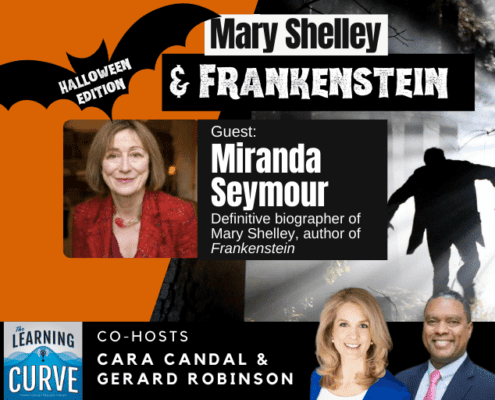
UK’s Miranda Seymour on Mary Shelley and Frankenstein for Halloween

UCLA’s Dr. Maryanne Wolf on Reading, Brain Science, & the Digital Age

Jeff Wetzler, Co-founder of Transcend, on Innovation in School Design
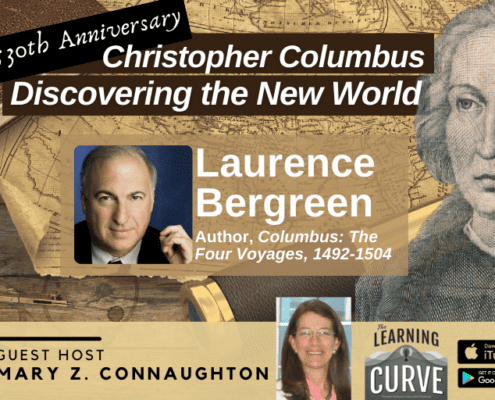
NYT Best Seller Laurence Bergreen on 530th Anniversary of Christopher Columbus Discovering the New World

NACSA’s Dr. Karega Rausch on Charter Public School Authorizing
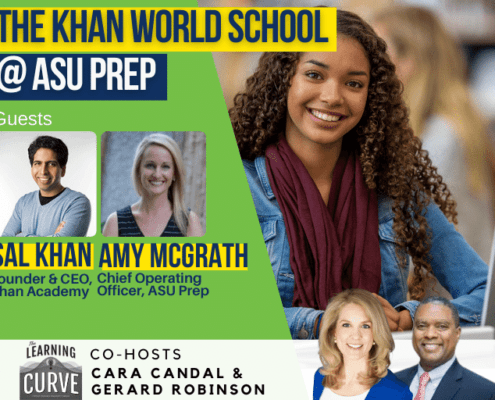
Khan Academy’s Sal Khan & ASU Prep Digital’s Amy McGrath on the Khan World School @ ASU Prep
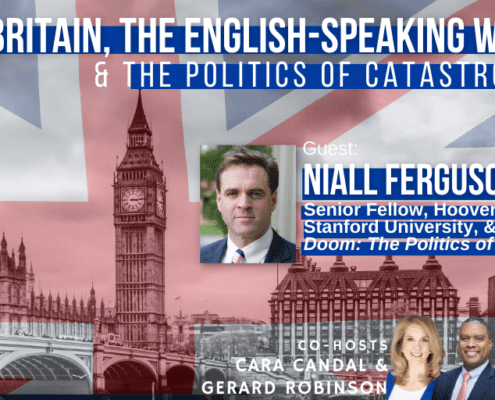
Hoover at Stanford’s Dr. Niall Ferguson on Britain, the English-Speaking World, & the Politics of Catastrophe
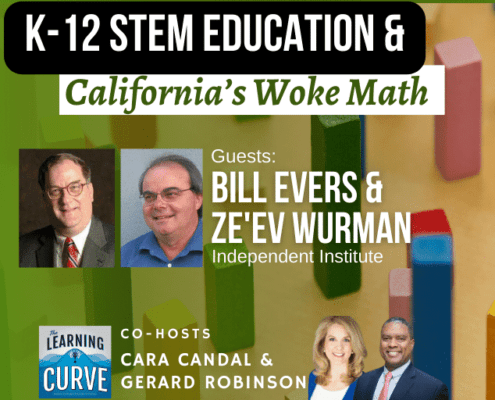
Independent Institute’s Dr. Bill Evers & Ze’ev Wurman on K-12 STEM Education & California’s Woke Math

Oxford’s Prof. Timothy Garton Ash on Poland’s Solidarity, Lech Walesa, & Cold War Lessons for Ukraine

UVA’s Prof. Angel Adams Parham on Classical Education, Black Intellectuals, & Homeschooling
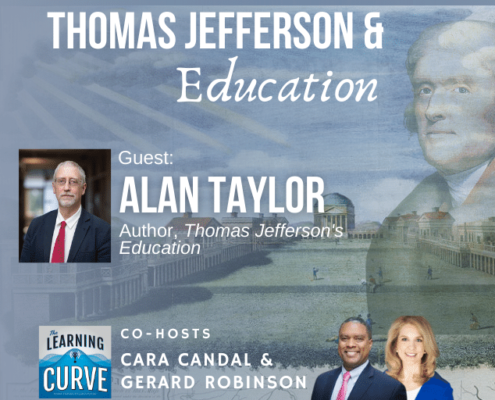
UVA’s Two-Time Pulitzer Winner Prof. Alan Taylor on Thomas Jefferson & Education
